SDG 8 – “Promote sustained, inclusive and sustainable economic growth, full and productive employment and decent work for all” – has 10 general targets and 2 means of implementation targets.1 There are 17 indicators.
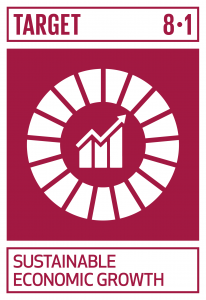 |  | 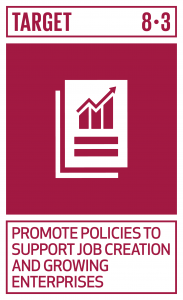 | 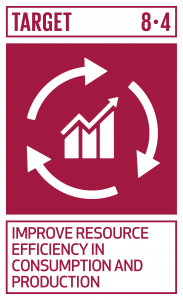 |
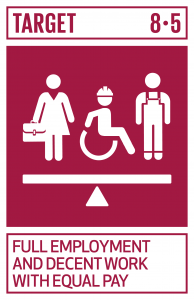 | 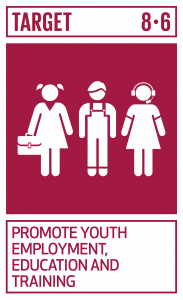 |  | 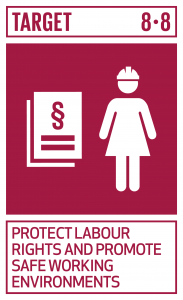 |
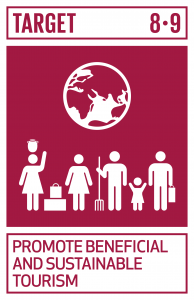 |  |  | 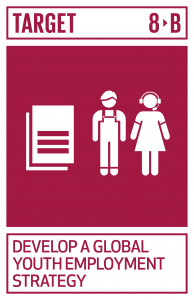 |
Some of these targets are more relevant for Cambodia than others. For example, Cambodia has already achieved the minimum 7% gross domestic product growth per annum set for least developed countries (target 8.1) – growth was 7.3% in 2018.2
The specific indicator for this target is actually for an annual GDP growth rate per capita, but even here Cambodia ranks comparatively well. Its 2017 growth per capita was 5.5%. This compares to an average of 2.5% for least developed countries and an average 3.9% for lower middle income countries.3
Targets around technology and innovation (8.2 and 8.3) present more of a challenge. In the Global Innovation Index for 2018, for example, Cambodia ranked comparatively poorly, at 98th out of 126 countries.4
Parts of some targets are already included in the Cambodian Constitution and Cambodian laws. For example:
- Article 36 of the Constitution which includes the sentence “Khmer citizens of either sex shall receive equal pay for equal work”5 is directly comparable with the second part of target 8.5.
- The Labor Law sets a minimum age for paid employment at 15 years and outlaws forced labor,6 applicable to target 8.7
- The Law on Suppression of Human Trafficking and Sexual Exploitation prohibits human trafficking,7 applicable to target 8.7.
The coverage of a target in the Constitution or a law does not automatically mean that the target has already been achieved in practice, of course.
Transition from the MDG targets to SDG 8 in Cambodia
None of the Cambodian Millenium Development Goals that applied until 2015 directly targeted economic growth. Economic growth would result, however, from targeted reductions in poverty and improvements in education, health and so on. MDG 8 – Develop a global partnership for development – would also have resulted in stronger economies, but Cambodia set no targets for this.8
The CMDGs most closely matching SDG 8 targets were:
- CMDG 2 Achieve universal primary education (comparable with SDG 8.6).
- CMDG 3 Promote gender equity and empower women. Within this goal were targets for greater paid female employment in all sectors (comparable with SDG 8.5) and ending gender-based violence (comparable with SDG 8.7). Progress was made but the 2015 targets were not reached.
CMDG (3b) Performance9
CMDG (3b) Empower women in wage employment | |||||||
No. | Indicators | Achievements | |||||
Unit | 2000 | 2005 | 2010 | 2015 actual | 2015 target | ||
5 | Women in wage employment – all sectors | % | – | – | 42.2 | – | 50 |
6 | Proportion of women in wage employment – agricultural sector | % | 35.0 (1998) | 52.2 | 53.0 | 45.7 (2013) | 50 |
7 | Proportion of women in wage employment – industrial sector | % | 44 (1998) | 53.3 | – | 45.4 | 50 |
8 | Proportion of women in wage employment – service sector | % | 21.0 (1998) | 27.0 | 27.4 | 32.0 (2013) | 50 |
17 | Number of GBV protection orders issued | No. | – | – | – | – | – |
No data was provided for the indicator/target of ending gender-based violence. A framework for dealing with this problem was developed, however, with, for example:
- the Law on Prevention of Domestic Violence and the Protection of Victims (2005)
- the Law on Suppression of Human Trafficking and Sexual Exploitation (2008)
- the National Action Plan to Prevent Violence Against Women 2014–2018.
The government’s 2018 document setting out the CSDGs notes that “Combatting GBV is a specific challenge, and the early identification of reliable data is an absolute priority.”10
Localization of SDG 8 in Cambodia
Cambodia’s SDGs (CSDGs) were made public in November 2018. While the global framework of SDG 8 has 12 targets and 17 indicators, CSDG 8 has 5 targets and 12 indicators (see table below).
The global targets that were left out of the CSDGs are:
8.4 – Improve global resource efficiency in consumption and production and endeavour to decouple economic growth from environmental degradation
8.5 – Full and productive employment and decent work for all women and men, including for young people and persons with disabilities, and equal pay for work of equal value
8.6 – Substantially reduce the proportion of youth not in employment, education or training
8.7 – Take immediate and effective measures to eradicate forced labour, modern slavery, human trafficking and child labour
8.8 – Protect labour rights and promote safe and secure working environments for all
8.10 – Strengthen the capacity of domestic financial institutions to encourage and expand access to banking, insurance and financial services for all.
The table shows the targets and indicators the Government has selected for CSDG 8. These are largely concerned with supporting economic, business and trade growth.
Targets and indicators for CSDG 811
Targets | Indicators | 2019 | 2020 | 2025 | 2030 |
8.1 Increase economic growth per capita (7% at least of GDP in least developed countries) | 8.1.1 Annual growth rate of real GDP per capita (%)1 | 7 | 7 | 7 | 7 |
8.2 More economic productivity, technology and innovation | 8.2.2 Growth rate of online company registration, trade mark registration and issuing certificate of origin |
|
|
|
|
8.2.2.1 Growth rate of online company registration (%) | 183.32 | 184.89 | 192.73 | 200.58 | |
8.2.2.2 Growth rate online trade market registration (%) | 189.59 | 189.32 | 188.01 | 186.70 | |
8.2.2.3 Growth rate of online issuing the certificate of origin (%) | 222.89 | 228.64 | 257.43 | 286.22 | |
8.2.3 Processing or development of products both goods and services through all available means through the OVOP concept |
|
|
|
| |
8.2.3.1 All kinds of products both goods and services that have been processed or developed and have been included in OVOP Movement (by number of type of product) | 125 | 175 | 300 | 500 | |
8.2.3.2 Number of types products both goods and services that have been processed or developed with OVOP standard criteria (by number of type of product) | 50 | 75 | 200 | 350 | |
8.3 Promote job creation, small businesses, innovation | 8.3.1 Growth rate of companies registered in the Chamber of Commerce (%) | n/a | n/a | n/a | n/a |
8.9 Promote local culture and sustainable tourism | 8.9.1 Tourism direct GDP as a proportion of total GDP and in growth rate (%) | 13.0 | 13.5 | 13 | 13.5 |
8.9.2 Number of jobs in tourism industries as a proportion of total employees in all sectors (%) | 7.0 | 7.5 | 8.0 | 11.0 | |
8.A Increase trade support in developing countries | 8.A.1 Aid for Trade commitments and disbursements (% of GDP) | 0.015 | 0.014 | 0.010 | 0.008 |
Note 1. The 7% figure appears in the Government document, but is actually the GDP growth rate, not the growth rate per capita.
SDG 8 is interlinked with other SDGs such as SDG 4 – improvements in areas such as education, research and innovation can lead to economic growth and jobs growth.
Means of implementation for SDG 8 in Cambodia
The CSDGs include the means of implementation target 8(a), “Increase Aid for Trade support for Cambodia, including through the Enhanced Integrated Framework for Trade-Related Technical Assistance”. The indicator is Aid for Trade commitments and disbursements for Cambodia, which is measured by total ODA disbursements to the trade sector by year compared to annual GDP.12. The baseline for 2016 was 0.018%. The targets are 0.014% for 2010, 0.010% for 2025 and 0.008% for 2030.13
This will be calculated annually by the Cambodian Rehabilitation and Development Board and the Council for the Development of Cambodia.14.
The Government has said that “Integrating the CSDGs within policy and resource planning in Cambodia involves embedding the framework within current policy making and administrative arrangements.”15 In particular, the Government has been working to integrate the CSDG framework into Cambodia’s new National Strategic Development Plan 2019–202316 and into the ministerial budgeting process.
Budgeting for the CSDGs is an enormous challenge, especially considering that Cambodia’s experience with the CMDGs showed up difficulties in trying to develop accurate costings over multiple sectors for long periods of time.
The CSDG programme will not be implemented in a push across the board: the Government has said that “…some ranking and phasing of targets and potentially goals will be inevitable and essential…”17 This will take account of unfinished business from the CMDGs (targets that were not met), the fit between the CSDGs and existing and new national objectives, and which policies drive progress across the whole CSDG agenda.
There will be a huge resourcing challenge in implementing the CSDGs. On the one hand, full implementation to achieve the targets will require an expansion of investment and resources. On the other hand, as Cambodia’s continuing economic success moves toward lifting it out of the category of least developed countries, the flow of aid money – still a significant part of the budget – will reduce.
Monitoring and evaluation of SDG 8 in Cambodia
Overall responsibility for national monitoring and evaluation lies with the Ministry of Planning. The Ministry will compile data and provide annual and five-yearly milestone reports. The operational CSDG framework is described in Schedules 1 and 2 of the November 2018 Government report.18
The responsible agencies/sources of data for specific indicators in CSDG8 are:
8.1.1 – Line ministries and agencies/Ministry of Planning, Ministry of Economy and Finance
8.2.2 – Ministry of Commerce/Admin data, Ministry of Commerce
8.2.3 – National Committee for One Village One Product (OVOP) Promotion and other relevant ministries and institutions/ Admin data of the National Committee for OVOP Promotion
8.3.1 – Ministry of Commerce/Admin data Ministry of Commerce
8.9.1 – Ministry of Tourism/Tourist survey
8.9.2 – Ministry of Tourism/Survey on labour in tourist sector
8.a.1 – Cambodia Rehabilitation and Development Board/Cambodia ODA database
The capacity and data systems of these responsible agencies will be strengthened through the National Strategy for the Development of Statistics.
Some of the indicators will be easy to report on because the framework for their measurement is already well established and readily available – GDP growth rates are a good example of this. The measurement of other indicators will require work – the number of goods and services processed or developed with OVOP standard criteria fall into this category.
Related Topics
References
- 1. SDG Knowledge Platform 2019. “SDG8”. Accessed 4 April 2019.
- 2. Asian Development Bank 2019. “Asian Development Outlook 2019“. Accessed 6 April 2019.
- 3. World Bank data 2019. “GDP per capital growth (annual %)“. Accessed 6 April 2019.
- 4. Cornell University, INSEAD, WIPO 2018. “Global Innovation Index 2018“. Accessed 6 April 2019.
- 5. Constitution of the Kingdom of Cambodia 1993. Accessed 6 April 2019.
- 6. Royal Government of Cambodia 1997. “Labor Law“. Accessed 7 April 2019.
- 7. Royal Government of Cambodia 2008. “The Law on Suppression of Human Trafficking and Sexual Exploitation“. Accessed 7 April 2019.
- 8. Royal Government of Cambodia 2018. “Cambodia Millennium Development Goals – CRDB/CDC”. Accessed 15 March 2019
- 9. Ibid
- 10. Ibid
- 11. Kingdom of Cambodia 2018. “Cambodian Sustainable Development Goals (CSDGs)”. Accessed 16 March 2019
- 12. Ibid
- 13. Ibid.
- 14. Ibid
- 15. Ibid
- 16. Poch Sovanndy 2017. “SDG Localisation into Cambodian Context Progress, M&E Framework and Next Step“. Accessed 7 April 2019.
- 17. Kingdom of Cambodia 2018. op. cit.
- 18. Ibid

